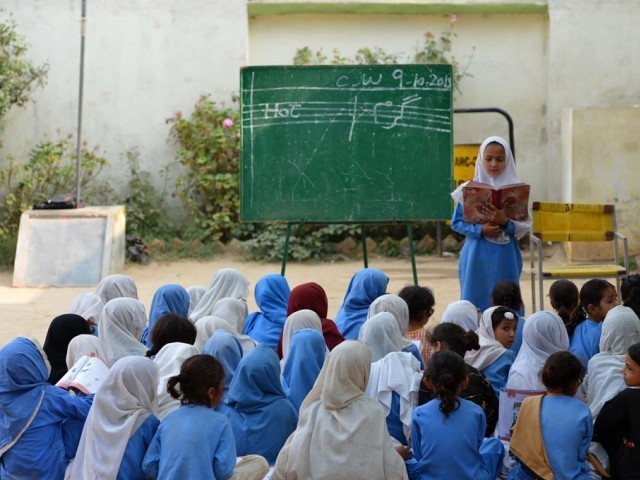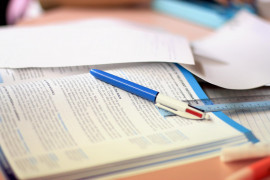
The World Economic Forum’s Global Gender Gap Report (2018), which measures economic participation and opportunity, educational attainment, health and survival, and empowerment, ranked Pakistan second-to-last globally and last regionally in South Asia.
Markers such as socioeconomic status, locality, and language have an impact on education outcomes, but gender most significantly impacts a student’s ability to perform well academically in Pakistan. Sindh province, in particular, illustrates this reality.
There was a time when Sindh province excelled, competing country’s number 1 province of Punjab in education outcomes. But OXFAM Pakistan’s recent report on a comparative analysis of gender responsive financing in Punjab and Sindh provinces (2016) revealed that gender parity has increased in Punjab by 3 per cent, whereas it has declined by the same percentage in Sindh. It also highlights that the majority of girls’ schools in Sindh do not have basic facilities like toilets, drinking water, or boundary walls.
Significantly, there are huge gender disparities in budget allocation for education in Sindh with only 19 per cent of its budget in 2016-17 earmarked for girls’ education, compared to 48 per cent of the budget for boys’ education. Gender responsive budgeting is also complicated by the opacity of major categories in the education budget, which are not disaggregated by gender.
Pakistan’s education statistics from 2016-17 also reveal alarming gender disparities in education in Sindh. Eight million students are enrolled in education institutions from primary to degree level in Sindh, of which just 42 per cent are girls.
However, approximately 6.4 million children are still out of school, the majority (53 per cent) of which are girls. Effective Transition Rate (ETR) between primary and lower secondary levels, which flags potential barriers in the education system, is also less than 80 per cent in Sindh, similar to Balochistan and FATA. Low Gross Enrolment Ratio (GER) coupled with low ETR results in a worrying phenomenon: many school-aged students, particularly girls, do not receive an education after lower secondary level.
Another key issue is the low number of female-only education institutions in Sindh. From pre-primary to degree colleges, there are 55,247 public and private educational institutions. The majority (61%) are male-only institutions, 19 per cent are mixed, and only 21 per cent are female-only educational intuitions.
Institutions for girls in rural areas are mere 15 per cent of the total educational institutions in Sindh, illustrating the inequality in providing access to education, which directly and disproportionately affects women and girls living in rural areas of the province.
Further compounding the low prevalence of girls’ schools in Sindh is a critical lack of female teachers in public schools, particularly in rural areas.
Female teachers constitute only 32 per cent of public institutions’ teaching workforce, a figure much lower than national average (42 per cent), and even lower than Balochistan and FATA (33 per cent). In rural Sindh, 80 per cent of the teaching workforce is male. While normatively, institutions prefer to recruit women at the primary level, women only comprise 26 per cent of teachers at this level, where the levels of enrolment are generally highest.
At the district level, the Sindh government’s data shows that Tharparkar has the lowest number (14 per cent) of female teachers compared to (86 per cent) male teachers, whereas Sujawal, Kashmore and Ghotki districts also report lower numbers of female teachers (20 per cent) in their teaching work force. This absence of female teachers deters parents from sending their girls to school past a certain age, thus significantly limiting their educational future.
Moreover, simply increasing access to education does not ensure quality. Thus, reform initiatives should address the gender biases in education textbooks. The government needs to prioritise and institutionalise revising textbooks and associated curricula through comprehensive gender review and analysis as regular practise.
In order to effectively address the glaring inequalities in the Sindh education system, women’s representation also needs to be equitable and responsive. Unfortunately, women’s representation in leadership positions and policy-making roles is also insignificant. Approximately 80 per cent of major educational institutions, such as STEDA, PITE, RSU, DCAR and Education Directorates, are mainly headed and dominated by men. Women lack any substantive representation in policy forums.
One recent success has been the establishment of a Gender Unit within the Sindh Education Department, a major hallmark which can promote gender-inclusive policy-making and ensure implementation of gender gap-closing agendas. The Gender Unit also engages with a working group tasked with advising and supporting the government on achieving gender parity in education.
However, the Gender Unit is not currently fully functional and still faces problems with a lack of required resources and capacity, which is indicative of the government’s commitment to gender equality in education at the strategic level. The Sindh Gender Unit — if fully funded, staffed and institutionalised — has the potential to model gender-equitable education across Pakistan and slowly regain its former position as a leader in delivering quality education systems.
Despite these setbacks, it is encouraging to observe that girls’ enrolment, while still comparatively low, is increasing in Sindh. However, given the gross enrolment ratio and transition rate, lack of girls’ schools, and dearth of female teachers, Sindh needs to make drastic and concerted efforts to respond to the gender gaps in its education system.
Education of girls, and subsequently that of women, will not improve without deliberate efforts, which are currently missing, notably in allocation of resources and implementation. Improving gender parity in education, with a focus on girls’ education, should be the first priority of the Sindh Education Department.
This goal can only be met by working systematically to address gaps, allocate resources, improve ground conditions, recruit female teachers, establish institutions, and strengthen gender analyses, reviews, and feedback loops to achieve equitable quality education.
Published in The Express Tribune, March 28th, 2019.
Like Opinion & Editorial on Facebook, follow @ETOpEd on Twitter to receive all updates on all our daily pieces.































































COMMENTS
Comments are moderated and generally will be posted if they are on-topic and not abusive.
For more information, please see our Comments FAQ